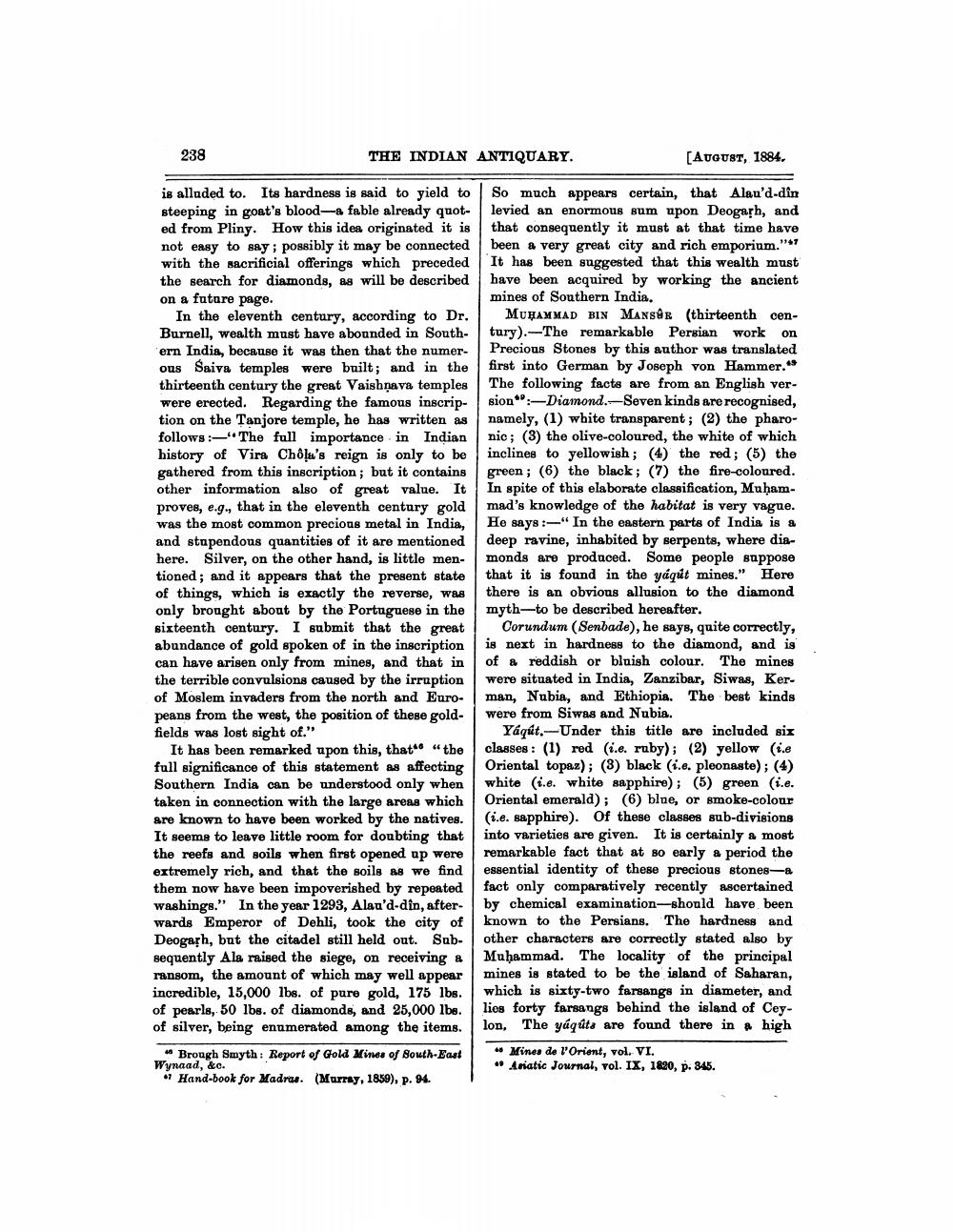________________
238
THE INDIAN ANTIQUARY.
is alluded to. Its hardness is said to yield to steeping in goat's blood-a fable already quoted from Pliny. How this idea originated it is not easy to say; possibly it may be connected with the sacrificial offerings which preceded the search for diamonds, as will be described on a future page.
In the eleventh century, according to Dr. Burnell, wealth must have abounded in Southern India, because it was then that the numerous Saiva temples were built; and in the thirteenth century the great Vaishnava temples were erected. Regarding the famous inscription on the Tanjore temple, he has written as follows:-"The full importance in Indian history of Vira Chola's reign is only to be gathered from this inscription; but it contains other information also of great value. It proves, e.g., that in the eleventh century gold was the most common precious metal in India, and stupendous quantities of it are mentioned here. Silver, on the other hand, is little mentioned; and it appears that the present state of things, which is exactly the reverse, was only brought about by the Portuguese in the sixteenth century. I submit that the great abundance of gold spoken of in the inscription can have arisen only from mines, and that in the terrible convulsions caused by the irruption of Moslem invaders from the north and Europeans from the west, the position of these goldfields was lost sight of."
It has been remarked upon this, that "the full significance of this statement as affecting Southern India can be understood only when taken in connection with the large areas which are known to have been worked by the natives. It seems to leave little room for doubting that the reefs and soils when first opened up were extremely rich, and that the soils as we find them now have been impoverished by repeated washings." In the year 1293, Alau'd-din, afterwards Emperor of Dehli, took the city of Deogarh, but the citadel still held out. Subsequently Ala raised the siege, on receiving a ransom, the amount of which may well appear incredible, 15,000 lbs. of pure gold, 175 lbs. of pearls, 50 lbs. of diamonds, and 25,000 lbs. of silver, being enumerated among the items.
[AUGUST, 1884.
So much appears certain, that Alau'd-din levied an enormous sum upon Deogarh, and that consequently it must at that time have been a very great city and rich emporium." It has been suggested that this wealth must have been acquired by working the ancient mines of Southern India.
1147
Brough Smyth: Report of Gold Mines of South-East Wynaad, &c. Hand-book for Madras. (Murray, 1859), p.
94.
MUHAMMAD BIN MANSUR (thirteenth century). The remarkable Persian work on Precious Stones by this author was translated first into German by Joseph von Hammer." The following facts are from an English version":-Diamond.-Seven kinds are recognised, namely, (1) white transparent; (2) the pharonic; (3) the olive-coloured, the white of which inclines to yellowish; (4) the red; (5) the green; (6) the black; (7) the fire-coloured. In spite of this elaborate classification, Muḥammad's knowledge of the habitat is very vague. He says:-"In the eastern parts of India is a deep ravine, inhabited by serpents, where diamonds are produced. Some people suppose that it is found in the yágút mines." Here there is an obvious allusion to the diamond myth-to be described hereafter.
Corundum (Senbade), he says, quite correctly, is next in hardness to the diamond, and is of a reddish or bluish colour. The mines were situated in India, Zanzibar, Siwas, Kerman, Nubia, and Ethiopia. The best kinds were from Siwas and Nubia.
Yaqút. Under this title are included six classes: (1) red (i.e. ruby); (2) yellow (i.e Oriental topaz); (3) black (i.e. pleonaste); (4) white (ie. white sapphire); (5) green (i.e. Oriental emerald); (6) blue, or smoke-colour (i.e. sapphire). Of these classes sub-divisions into varieties are given. It is certainly a most remarkable fact that at so early a period the essential identity of these precious stones-a fact only comparatively recently ascertained by chemical examination-should have been known to the Persians. The hardness and other characters are correctly stated also by Muhammad. The locality of the principal mines is stated to be the island of Saharan, which is sixty-two farsangs in diameter, and lies forty farsangs behind the island of Ceylon, The yágúta are found there in a high
Mines de l'Orient, vol. VI.
49 Asiatic Journal, vol. IX, 1820, p. 345.




